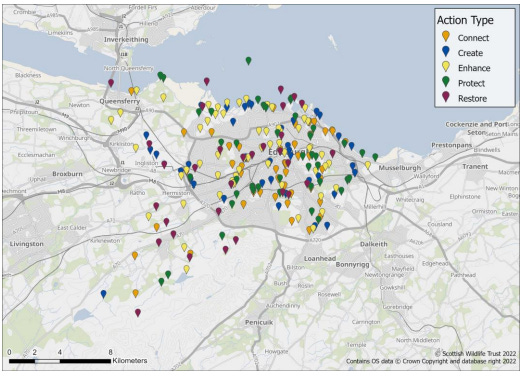The importance of green spaces for enhancing the quality of urban areas and for the health and wellbeing of residents is now well established. In response cities around the world are developing strategies to ‘green’ their city as part of plans for environmental improvement and as an important element of zero-carbon initiatives. This note takes a look at the Thriving Green Spaces project in Edinburgh to create the first Nature Network in the country as the first pilot gets underway. More comprehensive pieces about approaches to greening cities will follow in up-coming essays here in Policies for Places.
What are Nature Networks?
A Nature Network is a strategic long-term approach to manage, restore and enhance Scotland’s habitats and landscapes. Developing this approach is a commitment in the current Scottish Government’s program for government, and is included in the Government’s national Planning Framework. A Nature Network is both an attempt to produce thriving natural ecosystems and also a way to bring together government, industry, land managers, non-profits and communities to restore and enhance nature for the benefit of wildlife and the community. Nature networks are not just wild spaces – they are part of urban environments too, through such features as nature friendly gardens, urban parklands, green roofs on buildings together with interconnecting footpaths, roadside verges, rivers and streams.
Edinburgh’s Thriving Green Spaces Pilot
Edinburgh has embarked on a strategy – the Thriving Green Spaces Project -to find better ways to connect people in the city with the wide variety of natural habitats within the city. City of Edinburgh Council have been undertaking preparatory work over the past year. Working with the Scottish Wildlife Trust and Edinburgh University over 200 sites have been identified for actions that could be taken to create an Edinburgh Nature Network.
The Leith area of the city has now been designated as a pilot for the implementation of the Nature Network, Scotland’s first. Leith has been selected as the pilot location because of its high population and rich ecosystems in parks, rivers and shoreline. The Council has identified six parks in Leith with the lowest biodiversity levels as their primary focus.
A co-design approach
At the beginning of this month Edinburgh Council has hosted a face-to-face meeting and a virtual event to raise awareness and promote community involvement in the project. The objective of the events was to engage local stakeholders in the design process. Future meetings are scheduled for coming months to take this process forward. In particular the intention is to
• Establish a grassroots community initiative benefiting from outdoor space
• Create learning and development opportunities through storytelling and biodiversity enhancement
• Improve biodiversity in Leith's parks
• Develop inclusive environments
• Address potential antisocial behaviour with the provision of enhanced public facilities.
The early meetings drew attention to accessibility considerations, including park access, internal park routes (e.g., raised flower beds, slopes as alternative routes for steps), and sensory gardens (smell and touch) to ensure inclusive benefits for the community and also the need for basic facilities for such things as re-cycling and rubbish bins, and ‘top-up taps’ for public use.
Updates will follow.





This reminds me of the Green Chain policies in London and around Paris providing citizens with alternative routes to walk or cycle away from congested, polluted streets. Chris Shepherd